Euntai Kim
Environmental Change Detection: Toward a Practical Task of Scene Change Detection
Jun 13, 2025Abstract:Humans do not memorize everything. Thus, humans recognize scene changes by exploring the past images. However, available past (i.e., reference) images typically represent nearby viewpoints of the present (i.e., query) scene, rather than the identical view. Despite this practical limitation, conventional Scene Change Detection (SCD) has been formalized under an idealized setting in which reference images with matching viewpoints are available for every query. In this paper, we push this problem toward a practical task and introduce Environmental Change Detection (ECD). A key aspect of ECD is to avoid unrealistically aligned query-reference pairs and rely solely on environmental cues. Inspired by real-world practices, we provide these cues through a large-scale database of uncurated images. To address this new task, we propose a novel framework that jointly understands spatial environments and detects changes. The main idea is that matching at the same spatial locations between a query and a reference may lead to a suboptimal solution due to viewpoint misalignment and limited field-of-view (FOV) coverage. We deal with this limitation by leveraging multiple reference candidates and aggregating semantically rich representations for change detection. We evaluate our framework on three standard benchmark sets reconstructed for ECD, and significantly outperform a naive combination of state-of-the-art methods while achieving comparable performance to the oracle setting. The code will be released upon acceptance.
A$^2$LC: Active and Automated Label Correction for Semantic Segmentation
Jun 13, 2025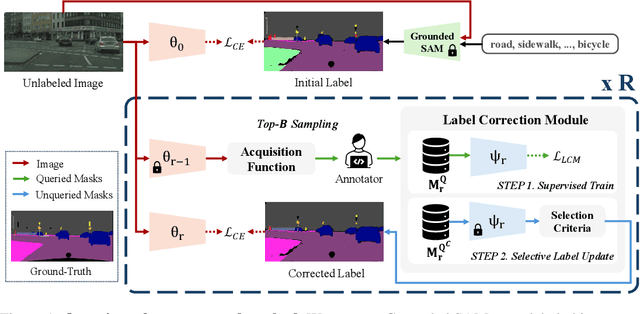
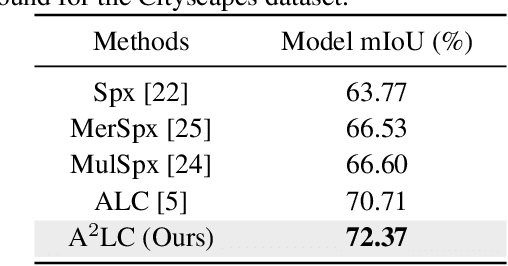

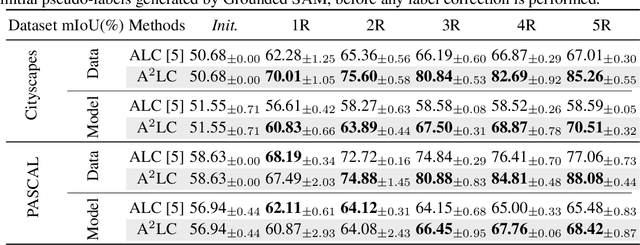
Abstract:Active Label Correction (ALC) has emerged as a promising solution to the high cost and error-prone nature of manual pixel-wise annotation in semantic segmentation, by selectively identifying and correcting mislabeled data. Although recent work has improved correction efficiency by generating pseudo-labels using foundation models, substantial inefficiencies still remain. In this paper, we propose Active and Automated Label Correction for semantic segmentation (A$^2$LC), a novel and efficient ALC framework that integrates an automated correction stage into the conventional pipeline. Specifically, the automated correction stage leverages annotator feedback to perform label correction beyond the queried samples, thereby maximizing cost efficiency. In addition, we further introduce an adaptively balanced acquisition function that emphasizes underrepresented tail classes and complements the automated correction mechanism. Extensive experiments on Cityscapes and PASCAL VOC 2012 demonstrate that A$^2$LC significantly outperforms previous state-of-the-art methods. Notably, A$^2$LC achieves high efficiency by outperforming previous methods using only 20% of their budget, and demonstrates strong effectiveness by yielding a 27.23% performance improvement under an equivalent budget constraint on the Cityscapes dataset. The code will be released upon acceptance.
HypeVPR: Exploring Hyperbolic Space for Perspective to Equirectangular Visual Place Recognition
Jun 05, 2025Abstract:When applying Visual Place Recognition (VPR) to real-world mobile robots and similar applications, perspective-to-equirectangular (P2E) formulation naturally emerges as a suitable approach to accommodate diverse query images captured from various viewpoints. In this paper, we introduce HypeVPR, a novel hierarchical embedding framework in hyperbolic space, designed to address the unique challenges of P2E VPR. The key idea behind HypeVPR is that visual environments captured by panoramic views exhibit inherent hierarchical structures. To leverage this property, we employ hyperbolic space to represent hierarchical feature relationships and preserve distance properties within the feature space. To achieve this, we propose a hierarchical feature aggregation mechanism that organizes local-to-global feature representations within hyperbolic space. Additionally, HypeVPR adopts an efficient coarse-to-fine search strategy, optimally balancing speed and accuracy to ensure robust matching, even between descriptors from different image types. This approach enables HypeVPR to outperform state-of-the-art methods while significantly reducing retrieval time, achieving up to 5x faster retrieval across diverse benchmark datasets. The code and models will be released at https://github.com/suhan-woo/HypeVPR.git.
RE-TRIP : Reflectivity Instance Augmented Triangle Descriptor for 3D Place Recognition
May 22, 2025Abstract:While most people associate LiDAR primarily with its ability to measure distances and provide geometric information about the environment (via point clouds), LiDAR also captures additional data, including reflectivity or intensity values. Unfortunately, when LiDAR is applied to Place Recognition (PR) in mobile robotics, most previous works on LiDAR-based PR rely only on geometric measurements, neglecting the additional reflectivity information that LiDAR provides. In this paper, we propose a novel descriptor for 3D PR, named RE-TRIP (REflectivity-instance augmented TRIangle descriPtor). This new descriptor leverages both geometric measurements and reflectivity to enhance robustness in challenging scenarios such as geometric degeneracy, high geometric similarity, and the presence of dynamic objects. To implement RE-TRIP in real-world applications, we further propose (1) a keypoint extraction method, (2) a key instance segmentation method, (3) a RE-TRIP matching method, and (4) a reflectivity-combined loop verification method. Finally, we conduct a series of experiments to demonstrate the effectiveness of RE-TRIP. Applied to public datasets (i.e., HELIPR, FusionPortable) containing diverse scenarios such as long corridors, bridges, large-scale urban areas, and highly dynamic environments -- our experimental results show that the proposed method outperforms existing state-of-the-art methods in terms of Scan Context, Intensity Scan Context, and STD.
DGS-SLAM: Gaussian Splatting SLAM in Dynamic Environment
Nov 16, 2024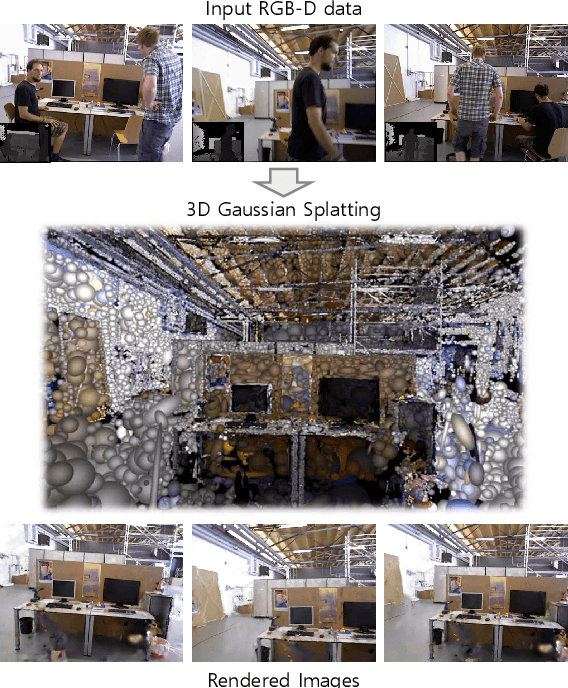
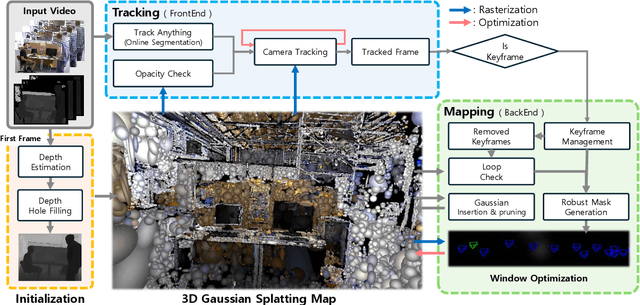
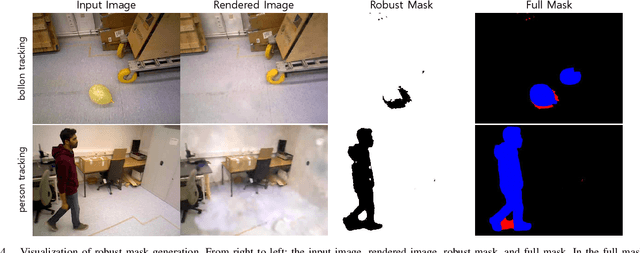

Abstract:We introduce Dynamic Gaussian Splatting SLAM (DGS-SLAM), the first dynamic SLAM framework built on the foundation of Gaussian Splatting. While recent advancements in dense SLAM have leveraged Gaussian Splatting to enhance scene representation, most approaches assume a static environment, making them vulnerable to photometric and geometric inconsistencies caused by dynamic objects. To address these challenges, we integrate Gaussian Splatting SLAM with a robust filtering process to handle dynamic objects throughout the entire pipeline, including Gaussian insertion and keyframe selection. Within this framework, to further improve the accuracy of dynamic object removal, we introduce a robust mask generation method that enforces photometric consistency across keyframes, reducing noise from inaccurate segmentation and artifacts such as shadows. Additionally, we propose the loop-aware window selection mechanism, which utilizes unique keyframe IDs of 3D Gaussians to detect loops between the current and past frames, facilitating joint optimization of the current camera poses and the Gaussian map. DGS-SLAM achieves state-of-the-art performance in both camera tracking and novel view synthesis on various dynamic SLAM benchmarks, proving its effectiveness in handling real-world dynamic scenes.
Decomposition of Neural Discrete Representations for Large-Scale 3D Mapping
Jul 22, 2024
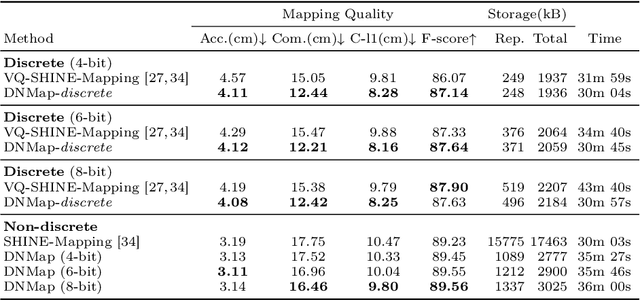
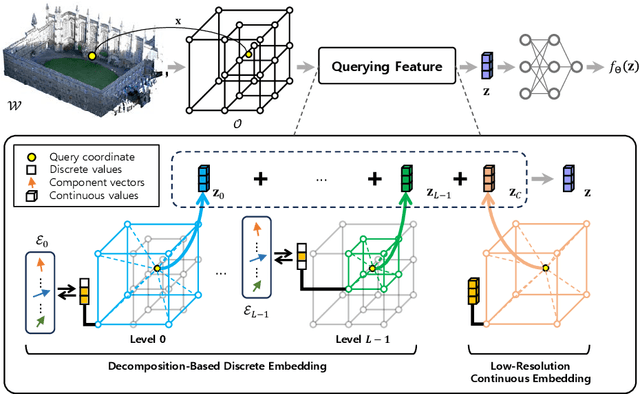
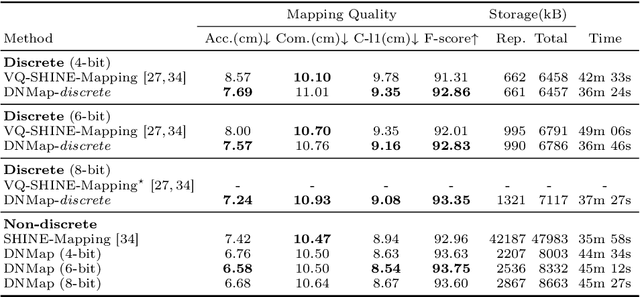
Abstract:Learning efficient representations of local features is a key challenge in feature volume-based 3D neural mapping, especially in large-scale environments. In this paper, we introduce Decomposition-based Neural Mapping (DNMap), a storage-efficient large-scale 3D mapping method that employs a discrete representation based on a decomposition strategy. This decomposition strategy aims to efficiently capture repetitive and representative patterns of shapes by decomposing each discrete embedding into component vectors that are shared across the embedding space. Our DNMap optimizes a set of component vectors, rather than entire discrete embeddings, and learns composition rather than indexing the discrete embeddings. Furthermore, to complement the mapping quality, we additionally learn low-resolution continuous embeddings that require tiny storage space. By combining these representations with a shallow neural network and an efficient octree-based feature volume, our DNMap successfully approximates signed distance functions and compresses the feature volume while preserving mapping quality. Our source code is available at https://github.com/minseong-p/dnmap.
Fast Global Localization on Neural Radiance Field
Jun 18, 2024



Abstract:Neural Radiance Fields (NeRF) presented a novel way to represent scenes, allowing for high-quality 3D reconstruction from 2D images. Following its remarkable achievements, global localization within NeRF maps is an essential task for enabling a wide range of applications. Recently, Loc-NeRF demonstrated a localization approach that combines traditional Monte Carlo Localization with NeRF, showing promising results for using NeRF as an environment map. However, despite its advancements, Loc-NeRF encounters the challenge of a time-intensive ray rendering process, which can be a significant limitation in practical applications. To address this issue, we introduce Fast Loc-NeRF, which leverages a coarse-to-fine approach to enable more efficient and accurate NeRF map-based global localization. Specifically, Fast Loc-NeRF matches rendered pixels and observed images on a multi-resolution from low to high resolution. As a result, it speeds up the costly particle update process while maintaining precise localization results. Additionally, to reject the abnormal particles, we propose particle rejection weighting, which estimates the uncertainty of particles by exploiting NeRF's characteristics and considers them in the particle weighting process. Our Fast Loc-NeRF sets new state-of-the-art localization performances on several benchmarks, convincing its accuracy and efficiency.
Zero-Shot Scene Change Detection
Jun 17, 2024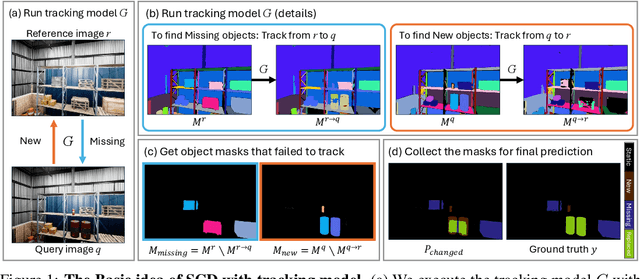

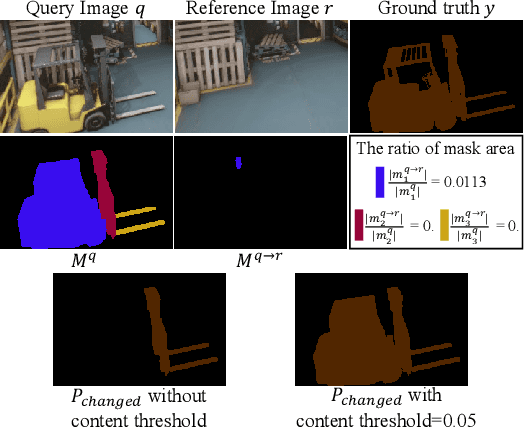

Abstract:We present a novel, training-free approach to scene change detection. Our method leverages tracking models, which inherently perform change detection between consecutive frames of video by identifying common objects and detecting new or missing objects. Specifically, our method takes advantage of the change detection effect of the tracking model by inputting reference and query images instead of consecutive frames. Furthermore, we focus on the content gap and style gap between two input images in change detection, and address both issues by proposing adaptive content threshold and style bridging layers, respectively. Finally, we extend our approach to video to exploit rich temporal information, enhancing scene change detection performance. We compare our approach and baseline through various experiments. While existing train-based baseline tend to specialize only in the trained domain, our method shows consistent performance across various domains, proving the competitiveness of our approach.
GRIL-Calib: Targetless Ground Robot IMU-LiDAR Extrinsic Calibration Method using Ground Plane Motion Constraints
Dec 21, 2023Abstract:Targetless IMU-LiDAR extrinsic calibration methods are gaining significant attention as the importance of the IMU-LiDAR fusion system increases. Notably, existing calibration methods derive calibration parameters under the assumption that the methods require full motion in all axes. When IMU and LiDAR are mounted on a ground robot the motion of which is restricted to planar motion, existing calibration methods are likely to exhibit degraded performance. To address this issue, we present GRIL-Calib: a novel targetless Ground Robot IMU-LiDAR Calibration method. Our proposed method leverages ground information to compensate for the lack of unrestricted full motion. First, we propose LiDAR Odometry (LO) using ground plane residuals to enhance calibration accuracy. Second, we propose the Ground Plane Motion (GPM) constraint and incorporate it into the optimization for calibration, enabling the determination of full 6-DoF extrinsic parameters, including theoretically unobservable direction. Finally, unlike baseline methods, we formulate the calibration not as sequential two optimizations but as a single optimization (SO) problem, solving all calibration parameters simultaneously and improving accuracy. We validate our \textit{GRIL-Calib} by applying it to three public real-world datasets and comparing its performance with that of existing state-of-the-art methods in terms of accuracy and robustness. Our code is available at https://github.com/Taeyoung96/GRIL-Calib.
SHUNIT: Style Harmonization for Unpaired Image-to-Image Translation
Jan 11, 2023
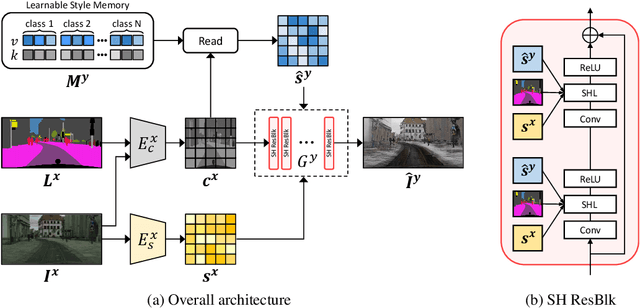

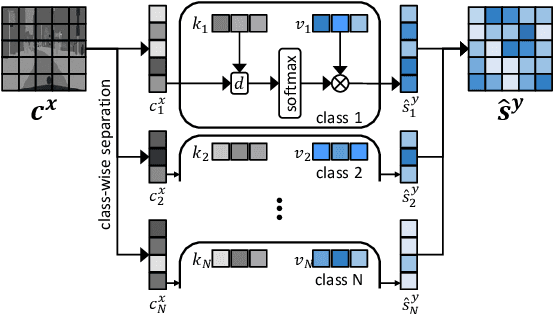
Abstract:We propose a novel solution for unpaired image-to-image (I2I) translation. To translate complex images with a wide range of objects to a different domain, recent approaches often use the object annotations to perform per-class source-to-target style mapping. However, there remains a point for us to exploit in the I2I. An object in each class consists of multiple components, and all the sub-object components have different characteristics. For example, a car in CAR class consists of a car body, tires, windows and head and tail lamps, etc., and they should be handled separately for realistic I2I translation. The simplest solution to the problem will be to use more detailed annotations with sub-object component annotations than the simple object annotations, but it is not possible. The key idea of this paper is to bypass the sub-object component annotations by leveraging the original style of the input image because the original style will include the information about the characteristics of the sub-object components. Specifically, for each pixel, we use not only the per-class style gap between the source and target domains but also the pixel's original style to determine the target style of a pixel. To this end, we present Style Harmonization for unpaired I2I translation (SHUNIT). Our SHUNIT generates a new style by harmonizing the target domain style retrieved from a class memory and an original source image style. Instead of direct source-to-target style mapping, we aim for source and target styles harmonization. We validate our method with extensive experiments and achieve state-of-the-art performance on the latest benchmark sets. The source code is available online: https://github.com/bluejangbaljang/SHUNIT.
 Add to Chrome
Add to Chrome Add to Firefox
Add to Firefox Add to Edge
Add to Edge